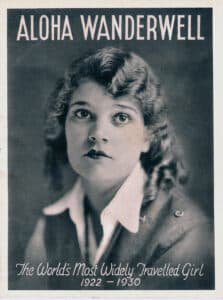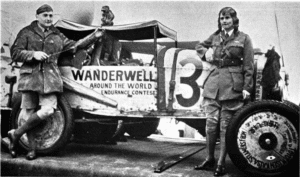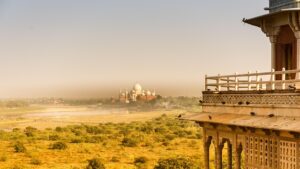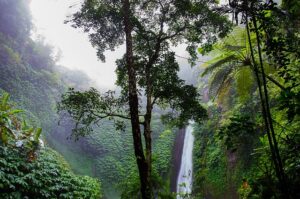“Brains, Beauty, & Breeches — World Tour Offer For Lucky young woman… Wanted to join an expedition…”
That was the ad that Aloha Wanderwell saw in 1922, and right away, she felt as if it had been written especially for her. She was only 16 years old but already knew that being a “proper young lady” was not for her. From a young age, she had an unquenchable thirst for adventure. Aloha was just waiting for the right opportunity and now knew she had found it.
Seventy-five countries and 380,000 miles later, Aloha Wanderwell had become the first woman to drive around the world, earning the moniker of “the Amelia Earhart of the open road.”

Early Years
Aloha Wanderwell was born Idris Galcia Welch on October 13, 1906, in Winnipeg, Manitoba, Canada, to Margaret Hedley and Robert Welch, both hailing from the northeast of England. However, Welch died soon after, and in 1908 Margaret married Herbert Hall, and Aloha grew up as Idris Hall alongside a younger sister named Margaret aka “Miki.”
The foursome lived on Vancouver Island where Herbert Hall worked as a rancher. He came from a posh Nottinghamshire family that was once quite a big deal back in the old country. His grandfather, Thomas Dickinson Hall, was Lord of Whatton and even served as the Sheriff of Nottingham. Herbert, however, broke off from family tradition and set sail for Canada because he had an inkling for fame, fortune, and, adventure, that he would pass on to Aloha.
In 1911, the family took a gamble when they heard rumors that a new railway line would be built on the island. They sold all their properties and bought a 40-acre promontory on Qualicum Beach. That year, the girls stayed with their relatives while Herbert and Margaret lived out of a tent as they built a cabin on their property, which they then used as temporary shelter while their new family home was being constructed. The sisters didn’t mind, though. They loved their time at Qualicum Beach, which they spent exploring the forests, paddling in the shallow waters, and befriending the local deer with gifts of apples, crackers, and their daddy’s beer.
Unsurprisingly, they also spent lots of time at the beach, having picnics and listening to music on their gramophone. Young Idris particularly enjoyed a record with ukulele music and would do a hula-style dance to it. She often used it to entertain guests when her mother asked her to “do [her] Aloha dance.” And that’s the origin story of her name.
Things were going well but, like many others, their lives changed forever when World War I started. In 1915, Hall joined the Canadian Expeditionary Force. He died in combat two years later at Ypres. This had a devastating effect on Idris for two reasons. First was the obvious loss of her father figure. Second, because this was when she found out that Herbert Hall was not her biological dad.
Idris started feeling like she didn’t belong. She had a sense of isolation and wanderlust which only grew stronger when her mother decided to send her and her sister to a Catholic girls’ school in Belgium because Herbert had wanted to give them a “continental education.”
Young Rebel
At the school, Miki was the prize pupil, but the same could not be said for her older sister. Idris had always been a tomboy and now she was entering her rebellious teenager phase. She didn’t like obeying the nuns’ orders. She wanted excitement, not piety. She looked up to Hollywood icons like Mary Pickford, not Mother Superior.
Eventually, Idris got expelled after the headmistress found her diary full of fantastical tales of adventure, including plans to run away from the school. According to her book, when the Mother Superior confronted Idris, she was so angry that they had taken her secret journal that she clocked the nun right in the kisser. This might be a bit of an embellishment on her part, but Idris was out of the school. The timing worked out pretty well, though. Her mother had sold their property in Canada and bought a villa in Nice where the girls continued their education. It was a much more relaxed atmosphere, but still not relaxed enough to quell Idris’s lust for excitement. Then, in 1922, she met Captain Wanderwell.
His real name was Valerian Johannes Pieczynski and he was born in Poland. He changed his name to Walter Wanderwell. He wasn’t actually the captain of anything, he just liked to be addressed like that. Aloha called him Cap. He had a checkered past, which included a stint in prison for being a suspected German spy during the war. However, when Idris met him, he was grabbing headlines by taking part in an endurance race around the globe. Idris first saw him at a screening of his exploits where he signed an autograph for her and then pointed out his advertisement in the Paris Herald looking for a “lady secretary” to join the Wanderwell Expedition. In reality, the woman who would be part of this undertaking would have to serve as secretary, driver, mechanic, seamstress, saleswoman, interpreter, public speaker, camerawoman, cinematographer, actor, and probably a few more. Idris didn’t care, though. This was exactly the kind of adventure she dreamt about.
On the morning of December 20, 1922, Idris met with Captain Wanderwell at the Hotel Normandie in Nice where he gave her the down-low. There would be lots of traveling, filming, taking pictures, and giving press interviews, but more important was selling postcards, brochures, letters, and other promotional materials since that was what funded the expedition. Idris was immediately hooked and the next afternoon she attended another screening where she already started selling merch. She also met two other members of the team: an Italian man she called “il giornalista” and a Texan woman she dubbed “la divorcée.” Idris spent the night with the crew and traveled to the town of Menton the following day and a quick dash into Italy after that.
That weekend, Idris went home and told her mom what she had been doing and about wanting to leave on the expedition. Unsurprisingly, Margaret said no, but it wasn’t an “over my dead body” kind of rejection. After all, as a girl, Margaret sailed unaccompanied across the Atlantic and crossed Canada by train. She understood the itch that Idris was feeling but, as a mother, she was understandably concerned for her daughter’s safety. Eventually, she agreed to meet with Captain Wanderwell, and he won her over enough for Margaret to agree to a trial run in southern France. Not that it truly mattered since Idris had already made up her mind to run away if her mother said no.
There was just one thing that Idris wanted to change. She was looking for a name that was a bit more “showbusiness” so she became “Aloha Hall” for a short time, but adopted the Wanderwell name soon after.
Starting in Europe

On December 29, 1922, Aloha said goodbye to her mother and sister, jumped in the captain’s Ford Model T which was covered in autographs, sponsor logos, and advertising slogans, and set off to see the world. Crew members on the expedition changed frequently. Some got fed up with life on the open road while others only signed up for certain stretches. Cap wanted someone permanent, though, someone who could serve as the recognizable face of the expedition. It didn’t take long before it became obvious that Aloha was that someone. A 6ft attractive blonde with classic Hollywood good looks, she immediately grabbed people’s attention.
The European leg of the journey almost ended as soon as it started. From France, the team drove to Geneva. While staying at the Marquise Hotel, the captain leaned out the window to untie the flag, slipped on the icy windowsill, and plummeted through the glass roof of the restaurant. He was hurt and taken to the hospital and, to add insult to injury, newspapers around the world reported that Walter Wanderwell had tried to kill himself, with the New York Times running the headline “World Auto Tourist Suddenly Loses Mind.”
As for a distraught Aloha, she gathered all the promotional material, films, and cameras, put them in the car, locked it inside a garage, and boarded the train home. She feared that her adventure had already come to an end, but a week later she received a telegram from Switzerland:
“Am ready for work, come as soon as you can. – Captain Wanderwell”
Of course, that was all that was needed for Aloha to rejoin the expedition and the next few trips were far more pleasant. In Paris, Aloha met Hollywood icon Rudolph Valentino. In Beziers, she attended Mardi Gras. Then, in Barcelona, the Wanderwell team stayed at the swankiest hotel in town and were greeted by the Lord Mayor.
Aloha was slowly getting used to driving the Model T with all of its quirks such as having to drive backward uphill when low on gas because the tank had no fuel pump to feed gas to the engine and, instead, used only gravity. By the time the team left Spain, Cap had decided to add a third car to the expedition, which meant that Aloha would become a full-time driver.
A regular day typically involved traveling from town to town, drumming up as much local interest as possible, and then, in the evening, staging a lecture, a screening, or a vaudeville show. Whatever brought in the crowds so the team could sell their merch and promote their sponsors. Sometimes this worked well, like in Barcelona. Other times, not so well, like in Madrid and Pamplona. In Zaragoza, things went even worse as Cap had left for France to obtain a third car. Meanwhile, the other two members of the team, a man named Armstrong and a young woman named Fate announced that they intended to get married and abandon the expedition, leaving Aloha on her own.
With few other options, Aloha returned to France…again. She thought about going home, but one meeting with the captain had her swayed once more, especially after seeing the new car and realizing that it would be all hers. She said:
“My very own Jolly-Boat. I quickly took an initial fling behind the wheel. She purred… With muffler, her throb was smooth. [She was] built for derring-do.”
Germany represented the next large leg of their journey, but this was a country that had been destroyed by World War I and was experiencing hyperinflation. As Aloha discovered, for many Germans bread had become a luxury so few of them had any interest or means in buying brochures. Despite that, the crew still put on two shows in Hannover and Berlin to large crowds. Even if they didn’t sell anything, they could, at least, promote their sponsors.
In Poland, the expedition received a much more lavish welcome since Cap was Polish and had two brothers in the military there. They staged big shows in Warsaw and Krakow and then were preparing to cross the Carpathian Mountains into Romania. However, Aloha was feeling down because her feelings for Cap went unreciprocated. Even her 17th birthday had come and gone without even a mention. In Krakow, Aloha went out all night with an officer, hoping to illicit worry, maybe even jealousy from Cap. However, she was greeted more with the anger of an outraged parent and that was too much for her.
The next day, Aloha packed up her bags, went to the train station, and returned home to Nice. She had left the Wanderwell Expedition.
Trekking through Asia

Without Aloha, the expedition went on, passing through Eastern Europe, Turkey, the Levant, and into Egypt. The team received a hero’s welcome in Alexandria, more so than in any other country they had visited so far. This included a generous sum for expenses, plus the promise of another payment should they also come to Cairo, plus spare parts for the cars and a one-ton supply truck.
Everything was going well for them, but the same could not be said for Aloha back in Nice. Quite predictably, she got bored. It had only been three months when she announced that she was leaving again, looking to get back on the expedition in Egypt.
Aloha’s reunion with Cap in Cairo was friendly but still not quite as “friendly” as she would have hoped. After an extensive filming and sightseeing tour in Egypt, the plan was to go to Suez and take a ship to India. But there were a few bureaucratic snafus with their passports and they had to wait for three days in Suez, living on the deck of the Borulus. During that time, almost the entire team left, leaving just Aloha, Cap, and a mechanic named Jarocki.
The trio traveled to Massawa, in Eritrea, which was an Italian colony back then. There, they secured passage to cross the Red Sea into Yemen, and from there, they sailed to Bombay, or Mumbai, as we call it nowadays. The reduced crew meant that she had to drive one of the Fords all on her own and, to be honest, things didn’t exactly go swimmingly. Remember, though, Aloha was driving a Model T with dodgy steering that was old and clunky even back then. Not to mention that the city streets were filled with pedestrians, bicycles, carts, and even animals that didn’t regard the automobile as anything worth paying attention to.
At one point, Aloha got so flustered that she forgot what side of the road to drive and she clipped a gharry. And in case you have no idea what a gharry is (because we didn’t), it’s a type of horse-drawn cab. It wasn’t long before 150 angry locals had surrounded Aloha’s car, but her knight in shining armor came in the form of “a large gentleman [who] hopped out of a car, caught the driver by the neck and hurled him across the street. That cleared the way and I proceeded.”
The trek through India was long and arduous, and the crew was racing against the approaching monsoon season. There were highlights, like filming snake charmers at the Taj Mahal and resting in a luxurious old mansion in Allahabad. Also, Aloha was gifted a pet monkey. She called him Kim and knitted him a little sweater. So that was nice but there were also perils such as getting stuck in the Godavari River and having to drive through plague-infested towns. But everything ended well and their Indian journey concluded with a stay at the Grand Hotel in Calcutta before flying to Burma and then taking a steamer to Singapore.
This was in the summer of 1924 and Cap wanted to reach America by the end of the year. They could have done it right now, but Wanderwell couldn’t resist the temptation of crossing China by car (something which he had been warned would be absurd) and making a quick stop in the USSR.
Therefore, in August, Aloha was in Beijing, ready to set off on another laborious journey. As it happened, they were preparing to traverse China right as the Second Zhili-Fengtian War started, as the two factions fought for control of Manchuria. Here’s Aloha describing the ordeal:
“Our main anxiety was how to avoid that week’s bloody war zone. Corpses lay half covered, some bolt upright in ditches, hideous fly-blown limbs scattered by explosions. Sometimes we heard the boom of artillery…”
So, yeah, not a pleasant experience, but the Fengtian faction did welcome them with open arms, gave them supplies, provided them with a ton of great footage, and granted them safe passage through the territory.
In mid-October, the Wanderwell Expedition reached Vladivostok but had no intention of crossing Russia by car. They popped in for a quick “hello,” just enough time to celebrate Aloha’s 18th birthday with a fancy dinner and have her made an honorary colonel by the Soviet Army for “being the first demoiselle to pilot a motorcar to Siberia.”
After that, it was off to Japan. They found the Japanese extremely enthusiastic about their adventure and they were selling pamphlets and brochures faster than Cap could print them. In Tokyo, the Nippon Theater paid them $1,000 for ten shows, by far the highest rate they had ever earned. It was very tempting to extend their stay in Japan, but the expedition had a schedule to keep. Plus, Cap and Aloha were hopeful that their next leg of the journey would be their most profitable yet. They were headed to America.
The Finish Line in America
The Wanderwell Expedition arrived in San Francisco on January 5, 1925, after a quick stop in Honolulu. They were hoping for a big welcome and tons of publicity but, instead…they were arrested. Cap was accused of white slavery under the Mann Act. It was only at this time that Aloha found out about his seedy past by reading about it in the papers. For the first time, her confidence in him was shaken, but she was in love with him, so she stuck by Cap’s side and, finally, her dedication paid off. First, they were both released without charge since the police had no evidence against them. Then, they set off for Hollywood, a place that Aloha always fantasized about visiting. And, lastly, Cap proposed to her. They got married in April, in Riverside, and went on to have two children together: Valri and Nile.
A few years earlier, this would have been everything Aloha wanted. But looking back on it later, she barely talked about her marriage in her memoir. She knew that Cap slept around with many of the other women in their crew. She also knew that the proposal was more out of convenience, not genuine love, so that they could travel freely in America from state to state, without risking another arrest under the Mann Act. It’s not surprising that Aloha showed no grief a few years later, in 1932, when Cap was murdered aboard their yacht. She was even considered a suspect for a while. A man named William James Guy was tried for the crime, but acquitted. Nobody was ever convicted so the murder of Walter Wanderwell remains a cold case.
But that was in the future. For now, the newlyweds still had all of America ahead of them. Aloha used her time in Hollywood wisely by learning film editing to improve the quality of their footage, but also got to meet her idol, Mary Pickford, at the United Artists studio. Pickford’s husband, fellow A-lister Douglas Fairbanks, had quite a fascination with their adventurous expedition, and the Hollywood couple even christened the Wanderwells’ fourth Model T dubbed “Miss Los Angeles.”
The first leg of the trip through the Sierra Nevada mountains was also the most arduous. From Nevada onwards, the going was a lot smoother, which was good news for Aloha since she was pregnant.
The team got bigger and two more cars were added to the expedition. As Cap predicted, their shows were big hits in almost every city: Salt Lake City, Denver, Kansas City, St. Louis… in Detroit, they even got a big parade through downtown. That’s where they officially ended the “Million Dollar Wager,” the endurance race that started before Aloha joined. They also met with Henry Ford, who accepted one of their first Model Ts as a gift for the Ford Museum.
Technically, the expedition had come to a close, which worked out well since Aloha was too ill and pregnant to keep going. It was time for her to settle down somewhere, which she did in Miami where she gave birth to her first child. But, of course, this didn’t last, as she still had the adventure bug inside her. First, the Wanderwells made a voyage to Cuba. Then, they traveled up the east coast of the United States and into Canada. This, however, was just an appetizer for the main course – Africa.
Africa and South America

In October 1926, the Wanderwells sailed from New York to Africa, intending to travel from Cape Town to Cairo. But Aloha’s second pregnancy delayed the new expedition so she spent the first half of 1927 in South Africa, joined by her mother and sister. In May, however, she was raring to go.
This trip was a lot smoother than the previous ones, mainly because they weren’t hurting for funds and supplies, anymore. Aloha could focus her time on shooting films instead of selling brochures. In total, she made a dozen movies about her global adventures, most of which are now preserved at the Library of Congress.
During their travels, they passed by Mount Kilimanjaro, filmed the Maasai tribe in the Serengeti, and Aloha even fought a bout of malaria. The expedition drove on the eastern coast of Africa, passing through Mozambique, Tanzania, Kenya, Uganda, and Ethiopia. Only Sudan was left before reaching Egypt, but the team received some disturbing news in Ethiopia. A violent uprising had erupted in Sudan, with reports coming in of European tourists being killed. As far as Aloha could remember, it was the first time she saw Cap actually rattled by an obstacle they encountered, and he canceled the trip on the spot. Instead, they drove back to Kenya and secured passage on a steamer to France. In December 1927, Aloha Wanderwell was in Nice, finally back in the place where her long journey had started five years earlier.
The next few years were quieter, as Aloha worked on her movies, but in 1930 Cap had another idea – South America. It made sense, right? Specifically, they were going to trek through the Amazon rainforest in search of Captain Percy Fawcett, a famed explorer who vanished a few years earlier while looking for the legendary Lost City of Z.
The group left in March 1931. No more Model Ts this time. Instead, they flew a seaplane straight to the Brazilian state of Mato Grosso where Fawcett disappeared. Spoiler alert: They didn’t find him. However, they did meet the indigenous Bororo people. A few gifts quickly eased the tension and the crew was allowed to stay in the village. Aloha made a whole movie about it – The Last of the Bororos – which represents the earliest footage of this tribe. Not only that, but the Bororo chief even told them what happened to Fawcett and his crew – they all drowned in a whirlpool. No evidence for this has even been found, but it’s as likely as any other scenario. Overall, the Wanderwells’ South American trip was a success, even if it didn’t accomplish its original goal, which to be honest, nobody expected, anyway. It was mostly a publicity stunt.
So what was next for them? Cap toyed with the idea of buying a schooner to sail the South Seas, but, as we mentioned earlier, the adventures of the Wanderwells came to a sudden halt in 1932 when Walter Wanderwell was murdered. Also as we said, Aloha wasn’t exactly the grieving widow, and when the scandal died down, she married another man named Walter Baker and stayed married for 62 years.
Her time as Aloha Baker was decidedly quieter as she pursued a career in journalism and radio broadcasting. She continued to give lectures and hold screenings of her adventures until 1980 when she delivered her last presentation at the Museum of Natural History in Los Angeles, aged 74. She died on June 4, 1996, aged 89, but will forever be remembered as Aloha Wanderwell, The World’s Most Traveled Girl.



